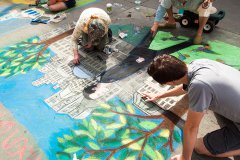Collaborazione
Cultura
Arts‐led regeneration strategies involve plans for how to involve wider groups in regenerative actions, through arts or design practices. Such activities engage local communities, schools, businesses, residents and other relevant groups through artist and community organised events, festivals, and urban interventions.
It is possible to reduce vandalism and money spent on ‘fighting’ graffiti vandalism by developing policies based on planning rather than policing (Iveson, 2009). Brighton and Hove City Council pointed out that greater collaboration with artists and with residents offered them a ‘win win’ situation, that in their experience, left less of a graffiti problem, less money to be spent on cleaning (Leach and Barker, 2010).
Arts‐led regeneration strategies recognise the desire of expression through graffiti (Halsey & Young, 2002). The arguments also recognise the frictions between tastes and ideas fundamental to democracy, which help us to see the opposition in opinion in a positive light and handled with constructive approaches (Walkeart, 2014; Iveson, 2009).
Some street art (legal and illegal in some instances) has also been recognised as an economic asset to local communities leading to regeneration of the area – e.g. bringing tourists to the areas, increasing property values and increasing business for traders, linked to arts led regeneration (Leach & Baker, 2010; Bristol City Council, 2011; Watts & Feeney, 2013; Young, 2014; BBC NEWS, 2014).
It is important to mention that there are mixed views on the value of the regenerative aspects of graffiti walls and mural projects (Stafford & Pettersson, 2003). The studies that evaluate the effectiveness of various approaches have different outcomes. For example, Stafford and Pettersson (2003) argue that legal walls and mural projects may attract graffiti to the local area. On the other hand, some studies argue that lack of spaces for practicing graffiti safely, alienates young people and limits their mobility (McAuliffe, 2013).

